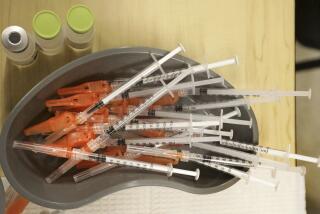Revising the Fine Print
WASHINGTON — Americans are “ignorant” when it comes to understanding diet and nutrition, said David A. Kessler, U.S. Food and Drug Commissioner, at a meeting of food journalists last week.
Kessler, one of the nation’s top food regulatory officials, recently counted himself among the uninformed.
“I considered myself nutritionally ignorant as well,” Kessler said during a panel at the National Press Club here.
Kessler said that when he became commissioner early this year, he wasn’t sure exactly what government recommendations meant when they suggested that adults should consume only 2,400 milligram of sodium a day or limit their daily fat intake to 70 grams.
“I’m a lawyer and a doctor, and if I didn’t know, then a lot of others didn’t either,” he said.
By illustrating the confusion over various health recommendations, Kessler underlined how important revisions in nutrition labeling on processed foods, being finalized by FDA, will be to improving the public’s diet.
“We will propose the most sweeping revisions of food labels in the nation’s history. They will be comprehensive and improve the health of Americans,” he said. “The label is an important public health tool.”
The Nutrition Labeling and Education Act requires that FDA issue the majority of its proposals by Nov. 8. The industry and public will then have an opportunity to comment before final regulations are issued sometime next year.
“Our primary responsibility is not to tell people what to eat but to tell them how to make informed choices about the foods they consume,” he said. “Government must ensure that the information people use to make (food) purchasing decisions must be accurate. And manufacturers must understand that.”
FDA has launched a number of highly publicized crackdowns on misleading label claims since Kessler assumed control of the agency in December.
“There is no place for marketing gimmicks on the food label,” he said. “If someone recovering from a heart attack goes into a supermarket--hoping to change his diet--then there is a lot at stake. People are so vulnerable to half truths--a product saying it is low cholesterol when it is actually high cholesterol.”
Since the FDA crackdown on misleading health claims, said Kessler, there has been a transition in the food industry. “In the past, some corporations went right up to the boundaries (of what is truthful) while others did everything by the book. When we are finished with this process then there will be no one at the boundaries,” he said.
FDA is considering six alternative label formats; by the time the multi-step process to improve and make nutrition labels more understandable is completed in 1993, Kessler said that more than 90% of all processed foods will have had their labels revised by the new format.
An industry trade group, which has criticized Kessler in the past for a “hunt and peck” approach to regulating labels, is concerned that some of the labels FDA is considering may stigmatize certain foods as unhealthy.
“The (Nutritional Labeling and Education Act) does (not) direct the FDA to develop a labeling format that calls for ‘good food/bad food’ labels,” said John Cady, president of the National Food Processors Assn. in Washington. “A good food/bad food label imposes subjective value judgment on a food or a component of a food. . . . Should government reasonably be allowed, through the food label, to tell each consumer to eat less of this or more of that?”
The labels being considered by FDA are reproduced here. These are all proposed labels for a can of baked beans. Which do you find most helpful? Write to us, Labels, Food Department, L.A. Times, Times Mirror Square, L.A. 90053 with your thoughts, and we will pass them on to the FDA.
More to Read
Inside the business of entertainment
The Wide Shot brings you news, analysis and insights on everything from streaming wars to production — and what it all means for the future.
You may occasionally receive promotional content from the Los Angeles Times.










